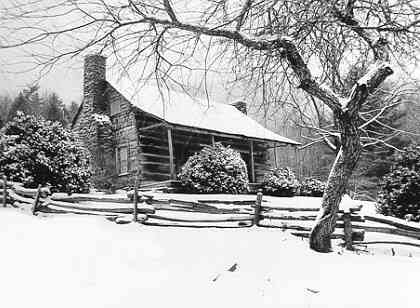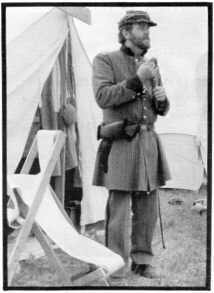
The Tellico Plains Mountain Press
& The Tellico Times

One can only guess what impressions might occur in the mind of any traveler passing through the town of Tellico Plains today. On first appearance, it may well seem to be like so many small Appalachian mountain valley towns, largely undeveloped and left behind in the tremendous industrial development of twentieth century America. However, Tellico Plains has more human history than any single person could ever master in a lifetime.
The archaeological work of Dr. Jefferson Chapman, published in Tellico Archaeology, testifies to the human habitation of this area for more than ten thousand years. One thousand years ago it was a site of an important Mississippian Mound Builders population center.
Tellico is located on a major crossroad of an important communication and transportation junction. The Great War Path linked the lower South with trade routes to the Ohio River to the Northeast, as well as population centers along the Atlantic seacoast of Virginia and the Carolinas. From Tellico the Unicoi Trail branched off over the mountains to the North Carolina Valley River and proceeded into Georgia and South Carolina.
In 1886, prior to the use of modern machines which plowed them down, John W. Emmert, working for the Smithsonian Institute, described the remains of a large populated Mississippian Mound Center in Tellico. Emmert wrote that within an area of four miles, there were 14 or 15 mounds, including a large one that was the most beautiful he had ever seen.
According to my researches, still without the blessing of professional researchers, a 600 man Spanish army under the command of Hernado Desoto spent two days in a village called Tali in July in 1540. The Desoto documents strongly suggest that Tali was Tellico. The native peoples who lived at Tali spoke a dialect of the Muskogee language and were subject to a chief whose political center was located in North Georgia. With the destruction left in the wake of the Desoto expedition, the remnants of these people emigrated southwestward and within about 100 years of the Desoto expedition, the Iroquoian speaking Cherokee begin to build their villages upon the site of Tellico Plains.
By 1700 the Cherokee were well established upon the site, and Englishmen from South Carolina begin to trade with the Cherokee . Col. George Chicken probably visited the site in 1715. By 1730, Motoy, the Cherokee Chief of Tellico was named and recognized by the English as" Emperor of the Cherokee."
By 1738, a European by the name of Priber attempted to establish a Utopian society in Tellico, calling himself Chief Motoy's Prime Minister. When the British government began to construct Fort Loudoun in 1756 British soldiers brought their supplies across the mountains on the centuries old trail across that intersected with the Great Warriors Trail at Tellico. Most current local citizens are acquainted with the fact that the Fort Loudoun garrison was massacred or captured by the Cherokee at the mouth of Cane Creek.
By 1776 the English conquest of the Cherokee had begun with invading armies, including William Christian and John Sevier who marched through Tellico across the Unicoi Trail, as well as southwestward to Chattanooga and North Georgia in their conquest of the native land and people. Local Monroe County historians, such as Walter Lumsden, have collected a wealth of history about the Unicoi Trail. Charles Baker has traced the trail from the Tellico River through Tellico Plains, step by step, to Fort Loudoun, using detailed documents in the care of Monroe County Historical Society.
When the Cherokee were at last defeated in battle in 1794 and Knoxville became a trade center for East Tennessee, White settlers in East Tennessee received many of their imported supplies over the Unicoi Turnpike. With the opening of the Old Federal Road in the early 1800's which by passed Tellico Plains, the vital crossroad link of Tellico began to decline in importance in communication and transportation. When the Cherokee were finally removed from the area in the early 1850's, Tellico Plains still served as an important communication link to Western North Carolina.

During the Civil War, Confederates commanded by men like General John Crawford Vaughn, and Union soldiers, such as Captain Bryson, traveled, fought and died upon the trail. Federal troops of General William Tecumseh Sherman destroyed the iron works at Tellico, as they prepared their famous march on Atlanta. Even the notorious Bushwhackers of Monroe County, including the Kirkland Gang, crossed and recrossed and fought, murdered and looted upon the Unicoi Trail. After the war, Thomas Boyd, a brother-in-law of General Vaughn, in 1871 faked his own death on the trail just south of Tellico Plains, in an attempt to escape Federal prosecution for a major Federal pension fraud of more than $l00,000.
By the beginning of the twentieth century, Tellico seemed to have slipped into an anonymity. Yet the Babcock Lumber Company revived for a period of time bustling activity with its center of operations on the Plains in the l920's.
In short, inquiring minds searching for adventure, mystery and romance in the pages of history, look to the Plains, look to the Tellico River and look to the mountains which encircle it. Exciting and adventuresome History permeates this small but important crossroads of history.
Copyright 1997 by Lowell Kirk, local Historian and History Professor at Hiwassee college.
Photographs by Jack Waters and David Vendola copyright 1997-2001.